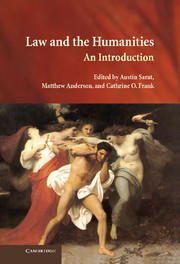Book contents
- Frontmatter
- Contents
- Contributors
- Acknowledgments
- Introduction: On the Origins and Prospects of the Humanistic Study of Law
- I PERSPECTIVES ON THE HISTORY AND SIGNIFICANCE OF SCHOLARSHIP IN LAW AND THE HUMANITIES: THREE VIEWS
- II IDEAS OF JUSTICE
- III IMAGINING THE LAW
- IV LINGUISTIC, LITERARY, AND CULTURAL PROCESSES IN LAW
- V INSTITUTIONAL PROCESSES
- 17 Trials
- 18 Testimony, Witnessing
- 19 Judgment in Law and the Humanities
- 20 Punishment
- Index
- References
17 - Trials
Published online by Cambridge University Press: 20 January 2010
- Frontmatter
- Contents
- Contributors
- Acknowledgments
- Introduction: On the Origins and Prospects of the Humanistic Study of Law
- I PERSPECTIVES ON THE HISTORY AND SIGNIFICANCE OF SCHOLARSHIP IN LAW AND THE HUMANITIES: THREE VIEWS
- II IDEAS OF JUSTICE
- III IMAGINING THE LAW
- IV LINGUISTIC, LITERARY, AND CULTURAL PROCESSES IN LAW
- V INSTITUTIONAL PROCESSES
- 17 Trials
- 18 Testimony, Witnessing
- 19 Judgment in Law and the Humanities
- 20 Punishment
- Index
- References
Summary
From the “Trial of the Century” to the Century of the Trial
On January 31, 2005, the “trial of the century” began in Santa Barbara, California, as pop star Michael Jackson was accused of conspiracy to abduct a child, as well as various other lewd acts against children. At the same time, on the other side of the world, another “trial of the century” was already in progress, that of Slobodan Milosevic, the former president of Serbia, before the International Criminal Tribunal for the former Yugoslavia for crimes against humanity and genocide. This trial followed on the heels of yet another “trial of the century” – the trial of two Libyan men in Camp Zeist, the Netherlands, accused of murdering the passengers of Pan Am flight 103 by exploding a bomb over Lockerbie, Scotland. This trial took place only a few years after the trial of O. J. Simpson for murder in 1995, a trial that was in its time widely claimed to be the trial of the century – albeit a different century. Indeed, it is possible to find the claim being made about large numbers of trials going back to the early years of the twentieth century – although in these earlier cases the claim is more often made by later commentators than contemporary observers. Thus other candidates for the “trial of the century” include variously the trial of Julius and Ethel Rosenberg (1951), the Nuremberg trials (1945), the Scopes “Monkey” trial (1925), the trial of Leopold and Loeb (1924), and back to the trial of Harry Thaw (1906) – and large numbers of trials in between.
- Type
- Chapter
- Information
- Law and the HumanitiesAn Introduction, pp. 455 - 477Publisher: Cambridge University PressPrint publication year: 2009



